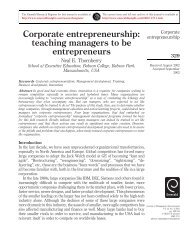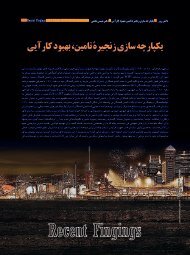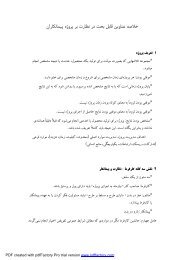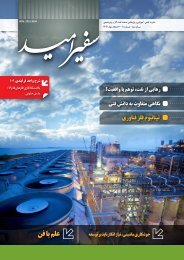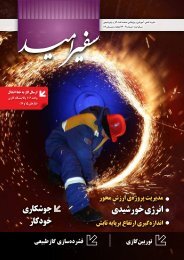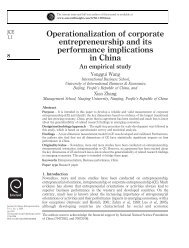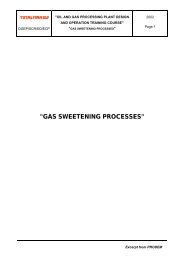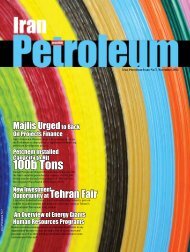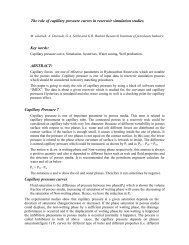NMR methods for determination of samples characteristics of oil ...
NMR methods for determination of samples characteristics of oil ...
NMR methods for determination of samples characteristics of oil ...
Create successful ePaper yourself
Turn your PDF publications into a flip-book with our unique Google optimized e-Paper software.
<strong>NMR</strong> <strong>methods</strong> <strong>for</strong> <strong>determination</strong> <strong>of</strong> <strong>samples</strong> <strong>characteristics</strong> <strong>of</strong> <strong>oil</strong>mk:@MSITStore:E:\Csearch.chm::/2086.htmPage 1 <strong>of</strong> 71/21/1998<strong>NMR</strong> <strong>methods</strong> <strong>for</strong> <strong>determination</strong> <strong>of</strong> <strong>samples</strong> <strong>characteristics</strong> <strong>of</strong> <strong>oil</strong>-saturated rocks:Comparison with results <strong>of</strong> traditional studiesDiyashev R.N, Musin K.M, Yudintsev E.A.TatNIPIneft inst., JSC Tatneft, Tatarstan, RussiaABSTRACTThe (<strong>NMR</strong>) is one <strong>of</strong> express <strong>methods</strong> enabling to study structure and properties <strong>of</strong> porous mediaand fluids, saturating them. In recent time application <strong>of</strong> <strong>NMR</strong> <strong>methods</strong> <strong>for</strong> aims <strong>of</strong> petroleum geologyexperiences second birth, associated with development <strong>of</strong> <strong>NMR</strong> logging <strong>of</strong> wells in a strong field. Thework shows feasibility <strong>of</strong> the method and estimates reliability <strong>of</strong> this method <strong>for</strong> <strong>determination</strong> <strong>of</strong> <strong>oil</strong>saturated rocks <strong>characteristics</strong> based on analysis <strong>of</strong> actual material accumulated <strong>for</strong> more than 2decades in JSC “Tatneft” (more than 65 thousand analyzed <strong>samples</strong>).INTRODUCTIONA physical basis <strong>of</strong> nuclear magnetic resonance method is influence <strong>of</strong> magnetic fields on behavior <strong>of</strong>atomic nucleus having an intrinsic magnetic moment. Most important among such elements are thenucleus С 13 and, especially, Н 1 . Actually nuclear magnetic resonance method uses nucleus <strong>of</strong> hydrogencontained in water and <strong>oil</strong>, as probes, by quantity <strong>of</strong> which conclusions on porosity and content <strong>of</strong> fluidsin <strong>samples</strong> are made, and mobility <strong>of</strong> fluids, wettability, permeability <strong>of</strong> porous matrix are evaluated .bydegree <strong>of</strong> interference <strong>of</strong> these nucleus and interstitial surface.Works on application <strong>of</strong> nuclear magnetic resonance <strong>for</strong> the purposes <strong>of</strong> petroleum geology have begunin the <strong>for</strong>mer Soviet Union and other countries <strong>of</strong> the world at the end <strong>of</strong> 1960-s. The leader in the field<strong>of</strong> practical application <strong>of</strong> nuclear magnetic resonance <strong>for</strong> the purposes <strong>of</strong> petroleum geology was JSC"Tatneft", where nuclear magnetic resonance procedures <strong>for</strong> studying reservoir rock properties wereincluded in usual practice.
<strong>NMR</strong> <strong>methods</strong> <strong>for</strong> <strong>determination</strong> <strong>of</strong> <strong>samples</strong> <strong>characteristics</strong> <strong>of</strong> <strong>oil</strong>mk:@MSITStore:E:\Csearch.chm::/2086.htmPage 2 <strong>of</strong> 71/21/1998Amplitude <strong>of</strong> a spin echo, as well as curves on times <strong>of</strong> spin-lattice relaxation (Т1) and spin-spinrelaxation (Т2) are directly measured values in <strong>NMR</strong>-pulse procedures. All other <strong>characteristics</strong> areobtained by mathematical treating <strong>of</strong> the measured magnitudes on the basis <strong>of</strong> various theoretical modelsand (or) statistical dependences (Fig. 1).Fig.1 – In<strong>for</strong>mational content <strong>of</strong> <strong>NMR</strong> methodPROBLEMS , SOLVED BY <strong>NMR</strong> METHODBy now in JSC "Tatneft" the following procedures are tested and quite widely applied:Determination <strong>of</strong> porosity. Distinctive feature <strong>of</strong> the method is the opportunity to determine porosity <strong>of</strong>core <strong>samples</strong>, not subjected to preliminary extraction (under condition <strong>of</strong> their 100 % saturation withfluids).Determination <strong>of</strong> water saturation (<strong>oil</strong>-saturation). For cores, taken on the basis <strong>of</strong> non-filtering drillfluid, the <strong>determination</strong> <strong>of</strong> water- or <strong>oil</strong>-saturation is possible. As the relaxation <strong>characteristics</strong> <strong>of</strong> somefractions <strong>of</strong> <strong>oil</strong> and water in a porous medium are very close, then, as against a situation with freevolume, the simple separation <strong>of</strong> parts <strong>of</strong> water and <strong>oil</strong> is impossible. There is a series <strong>of</strong> procedures,tested in TatNIPIneft, which provide solution <strong>of</strong> this problem. Their idea lies in selective influence onmagnitude <strong>of</strong> a relaxation time <strong>of</strong> one <strong>of</strong>phases. Such <strong>methods</strong> include congealing <strong>of</strong> <strong>samples</strong>, use <strong>of</strong> deuterated water or some other agents.Estimation <strong>of</strong> rock permeability by fluid and gas is per<strong>for</strong>med in accordance with chosen theoreticalmodel on basis <strong>of</strong> relaxation time and porosity, or distribution <strong>of</strong> pores and pore channels by size.Index <strong>of</strong> free fluid. By decomposition <strong>of</strong> relaxation curve into some components it is possible to
<strong>NMR</strong> <strong>methods</strong> <strong>for</strong> <strong>determination</strong> <strong>of</strong> <strong>samples</strong> <strong>characteristics</strong> <strong>of</strong> <strong>oil</strong>mk:@MSITStore:E:\Csearch.chm::/2086.htmPage 3 <strong>of</strong> 71/21/1998estimate portion <strong>of</strong> pore space occupied by movable fluid (<strong>oil</strong> or water).Residual or irreducible water saturation. From analysis <strong>of</strong> relaxation curves <strong>for</strong> 100 % saturated<strong>samples</strong> there is an opportunity to deter mine residual (irreducible) water saturation.Residual <strong>oil</strong> saturation. Residual <strong>oil</strong> saturation is determined using pulse- <strong>NMR</strong> method on amplitude<strong>of</strong> signal by direct process.Oils viscosity. Estimation <strong>of</strong> <strong>oil</strong> viscosity, remaining in pore space <strong>of</strong> a core after its recovery to thesurface is possible by means <strong>of</strong> corresponding empirical dependences based on data on relaxation times.The in<strong>for</strong>mation on rock wettability. Based on corresponding theoretical model through spin-latticerelaxation time the estimation <strong>of</strong> hydrophily or hydrophoby <strong>of</strong> rock interstitial surface is possible.The in<strong>for</strong>mation on efficiency and mechanismes <strong>of</strong> physico-chemical <strong>methods</strong> <strong>of</strong> enhanced <strong>oil</strong>recovery (EOR). The experience <strong>of</strong> JSC “Tatneft” demonstrates, that <strong>NMR</strong> is the effective means instudy <strong>of</strong> influence <strong>of</strong> various physico-chemical <strong>methods</strong> <strong>of</strong> enhanced <strong>oil</strong> recovery[1]. Laboratory <strong>NMR</strong>studies are per<strong>for</strong>med on standard (1 inch by diameter) cores using domestic <strong>NMR</strong>-relaxometers <strong>of</strong>"Echo" series, designed and made by Design Office "Radiophysics" in S-Petersburg State University.Working frequency <strong>of</strong> relaxometers - 20 MHz.OBJECTS OF STUDY.Main studies are carried out on core material from base terrigenous reservoirs <strong>of</strong> Devonian horizons(D 1D 0) and carbonate reservoirs <strong>of</strong> Tournaisian horizon in Romashkino <strong>oil</strong> field.Romashkino <strong>oil</strong> field, located in territory <strong>of</strong> Tatarstan Republic, Russia, was discovered in 1943. It is agiant field with the OOIP about 5.0 bln.t. In a sedimentary complex <strong>of</strong> the field there are more than 18<strong>oil</strong>-gas-bearing deposits, in that number 12 are under commercial development. Most productive are<strong>for</strong>mations <strong>of</strong> horizon D1, <strong>of</strong> Bobrik and Tournaisian stages, which from the very beginning aredeveloped by water displacement <strong>of</strong> <strong>oil</strong>.During the whole history in the field about 2.09 bln.t <strong>of</strong> <strong>oil</strong> has been produced. A maximum level <strong>of</strong> <strong>oil</strong>production in amount <strong>of</strong> 82 mln.t per year was achieved in 1970-1975.Development <strong>of</strong> sandy-aleurolite reservoirs <strong>of</strong> multilayer horizon D 1, as fractured-porous carbonatedeposits <strong>of</strong> Tournaisian stage by waterflooding <strong>methods</strong> requires constant control and management <strong>of</strong>displacement process with the purpose <strong>of</strong> imprority <strong>oil</strong> recovery. Among <strong>methods</strong> <strong>of</strong> reservoirs studies<strong>NMR</strong> <strong>methods</strong> occupy a highly important place.ANALYSIS OF DETERMINATION OF RESERVOIR PARAMETERS OF FORMATIONS D1
<strong>NMR</strong> <strong>methods</strong> <strong>for</strong> <strong>determination</strong> <strong>of</strong> <strong>samples</strong> <strong>characteristics</strong> <strong>of</strong> <strong>oil</strong>mk:@MSITStore:E:\Csearch.chm::/2086.htmPage 4 <strong>of</strong> 71/21/1998In total results <strong>of</strong> measuring 26195 <strong>samples</strong> are analysed, <strong>of</strong> which 13002 <strong>samples</strong>were studied by laboratory <strong>methods</strong> after extraction and 13193 <strong>samples</strong> – by <strong>NMR</strong> method in nonextractedstate. In Table 1 averaged values on <strong>determination</strong> <strong>of</strong> porosity and content <strong>of</strong> residual wateraccording to this sampling are given. Subsampling by lithotypes includes the <strong>samples</strong>, taken fromreservoirs zone only.As shown in table, discrepancies <strong>of</strong> average statistical values <strong>of</strong> rock porosity when measured bylaboratory method and by method <strong>of</strong> impulse <strong>NMR</strong> do not exceed one absolute percent in sampling onany lithotype or types <strong>of</strong> <strong>oil</strong> saturated rocks. Totally <strong>for</strong> all main lithotypes <strong>of</strong> rocks in reservoirs zonethe average statistical values <strong>of</strong> porosity made 0.03 % abs. It is obvious, that such differences <strong>of</strong>obtained values lie within the limits <strong>of</strong> errors <strong>of</strong> used <strong>methods</strong> and are not caused by peculiarities <strong>of</strong><strong>samples</strong> preparation and measuring <strong>methods</strong>. Indirectly such close values <strong>of</strong> porosity say aboutstatistical equivalence <strong>of</strong> given <strong>samples</strong>.Table1.Results <strong>of</strong> estimation <strong>of</strong> reservoir properties <strong>of</strong> <strong>for</strong>mations D1ItemLithotypeDetermination <strong>of</strong> porosity, % Residual water saturation, %Extract. (lab.)value/number <strong>of</strong><strong>samples</strong>Non-extract.(<strong>NMR</strong>) value/Extract. (lab.)value/number<strong>of</strong> <strong>samples</strong>Non-extract.(<strong>NMR</strong>) value/number <strong>of</strong><strong>samples</strong>Number <strong>of</strong><strong>samples</strong>1. Sandstones 20.6/5502 20.52/3816 16.8/4254 12.67/26342. Fine-grained sandstones 20.87/2359 21.09/2215 12.4/1902 10.7/14733. Fine-grained, aleurolite 20.51/1694 20.58/2363 14.16/1430 12.26/1501sandstones4. Aleurolites 17.62/608 18.36/838 23.32/348 19.76/4175. Clayey aleurolites 18.66/юо 17.86/133 24.44/62 23.36/496. Coarse-grained, sandy 18.23/487 18.87/758 19.34/334 16.37/352aleurolitesTOTAL <strong>for</strong> lithotype 20.35/10750 20.32/10123 15.77/8330 12.87/6426A somewhat different picture is received in analysis <strong>of</strong> obtained values <strong>of</strong> residual water saturation. Thediscrepancies between obtained values vary by <strong>samples</strong> <strong>for</strong> different lithotypes <strong>of</strong> rocks between 1.1%abs. and 4.13 % abs. Discrepancies in this case have pronounced systematic character. The averagestatistical values, obtained by impulse <strong>NMR</strong> method on non-extracted cores, in all cases appear lower,than the values obtained using method <strong>of</strong> saturating on extracted cores. On the average <strong>for</strong> all mainlithotypes <strong>of</strong> rocks the discrepancy in obtained values makes 2.9 % abs.Thus, the above mentioned absolute discrepancies in <strong>determination</strong> <strong>of</strong> residual water content on
<strong>NMR</strong> <strong>methods</strong> <strong>for</strong> <strong>determination</strong> <strong>of</strong> <strong>samples</strong> <strong>characteristics</strong> <strong>of</strong> <strong>oil</strong>mk:@MSITStore:E:\Csearch.chm::/2086.htmPage 5 <strong>of</strong> 71/21/1998extracted and non-extracted rocks <strong>of</strong> <strong>for</strong>mations <strong>of</strong> horizon D1 lead correspondingly to differences <strong>of</strong>being determined values <strong>of</strong> their <strong>oil</strong> saturation from 1.4 to 5% relat. <strong>for</strong> different lithotypes and 3.44%relat. – totally <strong>for</strong> all main lithotypes.ANALYSIS OF DETERMINATION OF RESERVOIR PARAMETERS OF TOURNAISIANSTAGEIn total results <strong>of</strong> measuring 39246 <strong>samples</strong> are analysed, <strong>of</strong> which 18028 <strong>samples</strong> were studied bylaboratory <strong>methods</strong> after extraction and 21218 <strong>samples</strong> – by <strong>NMR</strong> method. The studied <strong>samples</strong> werepresented mainly limestones <strong>of</strong> different types. In table 2 the averaged values on <strong>determination</strong> <strong>of</strong>porosity and content <strong>of</strong> residual water according to this sample are given. . In sampling by separatelithotypes the <strong>samples</strong>, taken only from layers, interpreted as reservoir, have been used.Results <strong>of</strong> estimation <strong>of</strong> reservoir properties <strong>for</strong> Tournaisian <strong>samples</strong>Table 2.ItemDetermination <strong>of</strong> porosity, % Residual water saturation, %Non-extract.(<strong>NMR</strong>) value/Non-extract.(<strong>NMR</strong>) value/Lithotype or type <strong>of</strong> <strong>oil</strong> Extract. (lab.)Extract. (lab.)saturation value/numbervalue/number<strong>of</strong> <strong>samples</strong> number <strong>of</strong> <strong>of</strong> <strong>samples</strong> Number <strong>of</strong><strong>samples</strong><strong>samples</strong>1. Limestones 11.7/3134 11.9/5037 41.6/2196 37.0/16372. Organogenic-detrital 12.7/3857 12.2/2886 39.7/2613 35.9/1812limestones3. Clot-detrital limestones 11.3/559 11.1/265 43.1/430 34.3/149TOTAL <strong>for</strong> lithotype 12.2/7550 12.0/8188 40.8/5239 36.3/3598In spite <strong>of</strong> significant difference <strong>of</strong> studied sample types (terrigenous and carbonate rocks), as in case <strong>of</strong><strong>for</strong>mation D 1, the discrepancy <strong>of</strong> average statistical values <strong>of</strong> porosity obtained by different <strong>methods</strong>,has not appeared great and does not exceed 0.5 % abs. Totally <strong>for</strong> main lithotypes <strong>of</strong> rocks thediscrepancy <strong>of</strong> average porosity values <strong>of</strong> extracted and non-extracted rocks made 0.2% abs.Nevertheless, though the results <strong>of</strong> comparison <strong>of</strong> porosity values point to statistical equivalence <strong>of</strong><strong>samples</strong>, the discrepancy between values <strong>of</strong> residual water saturation turned to be sufficiently high and,as <strong>for</strong> <strong>for</strong>mation D1, has pronounced systematic character. For various widely presented lithotypes <strong>of</strong>rocks it varies from 3.8 to 8.8 % abs., averaging 4.5 % abs. <strong>for</strong> lithotypes. As a result we can say thatdifference in average value <strong>of</strong> residual water content being 4.5% leads to difference in <strong>oil</strong> saturation <strong>of</strong>7.6% relat. The average statistical values <strong>of</strong> residual water content according to results <strong>of</strong> laboratory<strong>determination</strong> on extracted cores are always higher, than values determined using method <strong>of</strong> impulse
<strong>NMR</strong> <strong>methods</strong> <strong>for</strong> <strong>determination</strong> <strong>of</strong> <strong>samples</strong> <strong>characteristics</strong> <strong>of</strong> <strong>oil</strong>mk:@MSITStore:E:\Csearch.chm::/2086.htmPage 6 <strong>of</strong> 71/21/1998<strong>NMR</strong> on non-extracted <strong>samples</strong>.Similar picture is observed also in statistical averaging <strong>of</strong> residual water content in Tournaisian rocks byporosity intervals irrespective <strong>of</strong> rocks lithotype (Fig.2). In fact, practically over the whole spectrum <strong>of</strong>porosity the residual water content, being determined on extracted rocks by centrifugation method, ishigher than that, determined by <strong>NMR</strong> method on non-extracted sampls <strong>of</strong> rocks.The main reason <strong>for</strong> differences in residual water content seems to be not in different <strong>methods</strong> <strong>of</strong>investigation (centrifuging and <strong>NMR</strong>), but in influence <strong>of</strong> rocks extracting on physico-chemicalproperties <strong>of</strong> interstitial surface <strong>of</strong> rocks.Fig.2 - Measurements <strong>of</strong> residual water saturation <strong>for</strong> Tournaisian limestoneCONCLUSIONSStatistical analysis, per<strong>for</strong>med on collections, containing tens <strong>of</strong> thousands <strong>samples</strong>, has shown thatdiscrepancies in <strong>determination</strong> <strong>of</strong> porosity by <strong>NMR</strong> method and method <strong>of</strong> saturation make on theaverage 0.1 % <strong>for</strong> terrigenous rocks <strong>of</strong> <strong>for</strong>mation D1 and 0.2 % <strong>for</strong> Tournaisian carbonate rocks. Inmeasurement <strong>of</strong> residual water saturation (initial <strong>oil</strong> saturation) the influence <strong>of</strong> extraction is notable <strong>for</strong><strong>samples</strong> <strong>of</strong> <strong>for</strong>mation D 1(absolute deviation in <strong>determination</strong> <strong>of</strong> initial <strong>oil</strong> saturation up to 4.13 %,relative - up to 5 %), and is even more significant <strong>for</strong> Tournaisian limestones (absolute deviation up to8.8 %, relative - up to 15 %). It is obvious that further laborious methodical work in this direction isrequired.Substantial increase <strong>of</strong> validity <strong>of</strong> results, obtained using <strong>NMR</strong> method, can be achieved byimplementation in practice <strong>of</strong> multipulse <strong>NMR</strong> procedures, allowing to increase the number <strong>of</strong>
<strong>NMR</strong> <strong>methods</strong> <strong>for</strong> <strong>determination</strong> <strong>of</strong> <strong>samples</strong> <strong>characteristics</strong> <strong>of</strong> <strong>oil</strong>mk:@MSITStore:E:\Csearch.chm::/2086.htmPage 7 <strong>of</strong> 71/21/1998experimental points in relaxation curves while decreasing measurement time by one order <strong>of</strong> magnitude.[1] Application <strong>of</strong> <strong>NMR</strong> in petroleum geology // Muslimov R.Kh., Golovko S.N., Zakharchenko T.A., Zakharchenko N.L., Kazan, 1998, 104 p.




